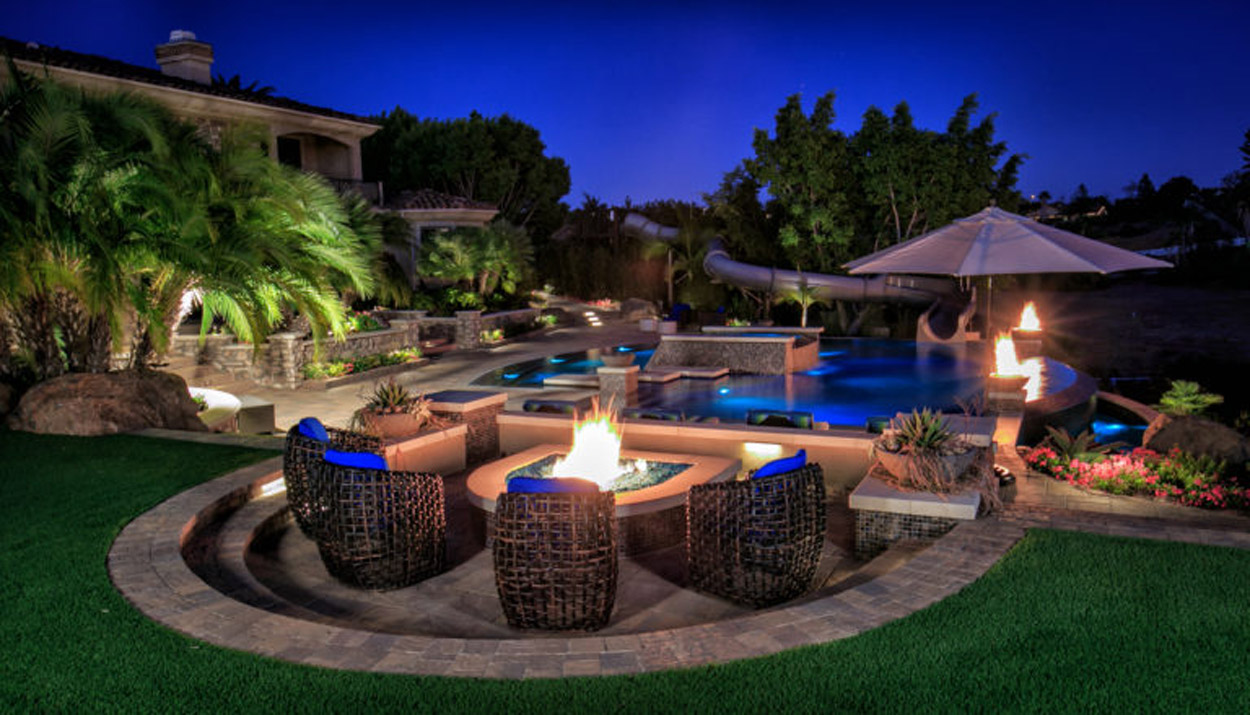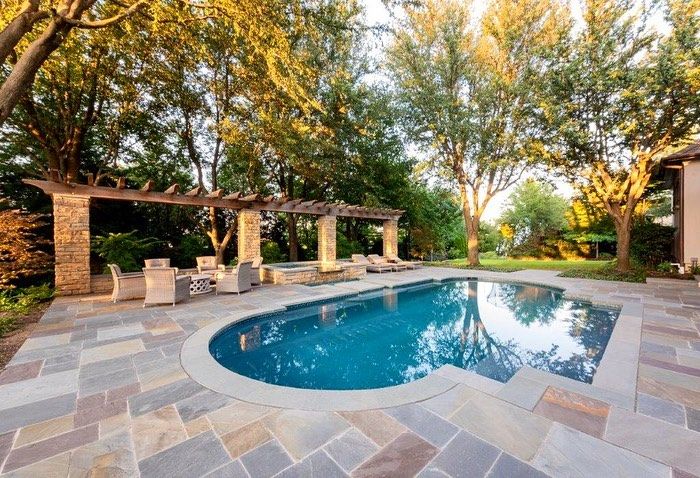Swimming pools provide a refreshing escape, but choosing the right size is crucial. This comprehensive article explores average swimming pool sizes and offers guidance on selecting the appropriate size based on factors such as user count, activities, space availability, budget, and local regulations.
By understanding the pros and cons of different pool sizes, readers can make an informed decision. Assessing the pool's primary purpose, user count, available space, and consulting professionals are key steps in choosing the perfect swimming pool size.
Key Takeaways
- Olympic-Size Pool Dimensions: 164 feet long (50 meters), 82 feet wide (25 meters), 7-10 feet deep, holds over 500,000 gallons of water.
- Standard Lap Pool Dimensions: Various sizes including 8 feet wide by 40 feet long, 10 feet wide by 80 feet long, 10 feet wide by 40 feet long, 10 feet wide by 60 feet long, and 8 feet wide by 50 feet long.
- Common Freeform Pool Dimensions: Various sizes including 16 feet wide by 30 feet long, 15 feet wide by 35 feet long, 18 feet wide by 40 feet long, 12 feet wide by 30 feet long, and 12 feet wide by 27 feet long.
- Common Fiberglass Pool Sizes: Standard size is 10 feet wide by 20 feet long, with sizes ranging from 8 feet wide by 15 feet long to 16 feet wide by 40 feet long.
Factors to Consider When Choosing Pool Size
One of the key factors to consider when choosing a pool size is the number of people who will use the pool regularly. This is an important consideration because the size of the pool will directly impact the functionality and enjoyment of the pool. It is essential to choose a pool size that can comfortably accommodate the number of users.
When selecting a pool size, it is important to consult a pool size guide to determine the dimensions that will best suit your needs. Consider the different pool size considerations such as the types of activities intended for the pool. If you plan on using the pool primarily for lap swimming or water aerobics, a standard lap pool size may be suitable. On the other hand, if you prefer a more relaxed and leisurely experience, a common freeform pool size may be more appropriate.
Another important consideration is the available space in your backyard. It is essential to choose a pool size that fits within the available space without compromising on safety or aesthetics. Additionally, your budget for construction and maintenance should also be taken into account when determining the pool size.
Local regulations and permits for pool construction should also be considered. Some areas may have restrictions on the size of the pool that can be built, so it is crucial to familiarize yourself with these regulations before finalizing your pool size.
Importance of Choosing the Right Size Pool
Choosing the right size pool is essential as it directly impacts the functionality and enjoyment of the pool. A pool that is too small may limit the activities that can be done, while a pool that is too large may require more maintenance and higher costs.
It is important to consider the number of users and available space in the backyard when selecting the size of the pool.
Size and Functionality
Determining the appropriate size of your swimming pool is crucial in ensuring optimal functionality and satisfaction for all users. Pool size planning involves considering various factors such as the number of regular users, intended activities, available space, budget, and local regulations.
The size of the pool directly affects its functionality and enjoyment. A pool that is too small may limit activities and the number of users, while a pool that is too large may require more maintenance and higher costs. Small pools require less maintenance and lower costs but may limit the number of users and activities.
Medium-sized pools offer a balance between functionality and cost but may require more maintenance. Large pools provide ample space for multiple users and activities but require higher maintenance and increased costs.
It is important to assess the primary purpose of the pool, consider the number of regular users and potential guests, evaluate available space, consult with a professional pool builder, and take into account long-term maintenance and cost implications.
Limitations of Small Pools
Small pools can have limitations that impact their functionality and overall enjoyment. When considering pool size suitability, it is important to understand the potential drawbacks of opting for a smaller pool. Here are three limitations of small pools:
- Limited space for activities: Small pools may not provide enough room for activities such as swimming laps, playing water sports, or hosting pool parties. This can restrict the overall enjoyment and functionality of the pool.
- Reduced number of users: Small pools may only accommodate a limited number of users at a time. This can be a disadvantage if you have a large family or frequently entertain guests.
- Higher maintenance and cost per square foot: While small pools may require less maintenance overall, the cost per square foot can be higher compared to larger pools. This is due to the fixed costs associated with building and maintaining a pool, regardless of its size.
Considering these limitations, it is crucial to carefully assess your needs and preferences when choosing the right pool size. Now, let's explore the maintenance and cost considerations in the next section.
Maintenance and Cost Considerations
Optimizing maintenance and cost considerations is crucial when selecting the appropriate size pool for your needs. Pool construction, pool size maintenance, and average pool dimensions are important factors to consider in order to make an informed decision.
The size of the pool directly impacts the amount of time, effort, and money required for its upkeep. Smaller pools generally require less maintenance and have lower costs associated with chemicals, heating, and cleaning. On the other hand, larger pools require more frequent cleaning, higher volumes of chemicals, and increased energy consumption for heating and filtration.
Pros and Cons of Different Pool Sizes
When considering the various pool sizes, it is important to weigh the advantages and disadvantages of different options. Each pool size has its own set of pros and cons that should be carefully considered before making a decision. Here are some key factors to keep in mind:
- Pool depth options: Different pool sizes offer different depth options, allowing for customization based on your preferences and needs. A larger pool can accommodate varying depths, which is ideal for families with children of different ages or individuals who enjoy various water activities. On the other hand, smaller pools may have limited depth options, restricting the types of activities that can be enjoyed.
- Selecting pool size: The size of your pool will greatly impact its functionality and the overall experience of using it. Smaller pools are easier to maintain and require fewer resources, making them cost-effective options. However, they may not provide enough space for multiple users or activities. Larger pools, on the other hand, offer ample space for various activities and allow for more users, but they require more maintenance and can be more expensive to construct and operate.
- Pool design: The size of your pool will also influence the overall design of your backyard. Smaller pools can be easily integrated into compact spaces, making them suitable for smaller yards. On the other hand, larger pools may require more space and can become the focal point of your outdoor area. It is important to consider the available space and layout of your backyard when selecting the size of your pool.
Tips for Assessing the Primary Purpose of the Pool
To accurately determine the primary purpose of the pool, it is essential to carefully assess the intended activities and prioritize them accordingly. This step is crucial in choosing the right pool size that will meet your needs and provide optimal functionality and enjoyment.
Start by considering the types of activities that will take place in the pool. Will it primarily be used for swimming laps, hosting pool parties, or providing a space for relaxation and leisure? Each activity has different space requirements. For example, if swimming laps is a priority, you will need a pool that is long enough to accommodate the length of your strokes. On the other hand, if the pool is mainly for hosting parties, you may want to prioritize a larger pool size to accommodate more guests comfortably.
Next, evaluate the number of regular users and potential guests. If you have a large family or frequently entertain guests, a larger pool size may be necessary to ensure everyone has enough space to enjoy the pool together. On the other hand, if the pool will primarily be used by a small number of people, a smaller pool size may be more suitable.
Additionally, consider the available space and layout of your backyard. It is important to choose a pool size that fits well within the available area without overwhelming the space or compromising other outdoor features. Take into account any existing landscaping, patio areas, or other structures that may impact the pool's size and placement.
Lastly, consulting with a professional pool builder can provide expert advice and guidance in choosing the right pool size based on your specific needs and preferences. They can also help you consider the long-term maintenance and cost implications of different pool sizes, ensuring that you make an informed decision.
Evaluating the Number of Regular Users and Potential Guests
Considering the number of regular users and potential guests is crucial in determining the appropriate size for your swimming pool. The size of the pool will directly impact the functionality and enjoyment of the space. Here are three key factors to consider when evaluating the number of regular users and potential guests:
- Usage frequency: Determine how often the pool will be used by regular users. If you have a large family or frequently entertain guests, a larger pool may be necessary to accommodate multiple people swimming at the same time. On the other hand, if the pool will only be used occasionally, a smaller pool might suffice.
- Preferred activities: Consider the types of activities that will take place in the pool. If you plan to have pool parties or engage in water sports, a larger pool with ample space for movement would be ideal. However, if the pool will primarily be used for relaxation or exercise, a smaller pool may be sufficient.
- Future growth: Anticipate any changes in the number of regular users and potential guests in the future. If you expect your family to grow or frequently host gatherings, it might be wise to choose a slightly larger pool to accommodate these changes.
Analyzing the number of regular users and potential guests will help you determine the appropriate size for your swimming pool, ensuring that it meets your current and future needs. Once you have considered this factor, you can move on to analyzing the available space and layout of the backyard.
Analyzing the Available Space and Layout of the Backyard
The available space and layout of the backyard should be carefully analyzed when determining the appropriate size for your swimming pool. It is crucial to consider these factors to ensure that the pool fits seamlessly into your outdoor space and meets your specific needs.
Firstly, you need to assess the dimensions of your backyard. Measure the available area and take note of any existing structures, trees, or landscaping features that may affect the pool's placement. This analysis will help determine the maximum size of the pool that can comfortably fit within the space.
Additionally, consider the layout of your backyard. Take note of any slopes, uneven terrain, or obstructions that may impact the pool's construction. It is essential to ensure that the pool can be safely and efficiently built in the chosen location.
Furthermore, think about how the pool will integrate with the rest of your outdoor living space. Consider the proximity to your home, patio, and other outdoor amenities. Analyze how the pool's placement will affect the overall flow and functionality of the backyard.
By carefully analyzing the available space and layout of your backyard, you can determine the appropriate size for your swimming pool. This analysis will ensure that the pool fits harmoniously into your outdoor space and enhances your overall enjoyment.
To further assist you in making an informed decision, it is advisable to consult with a professional pool builder for expert advice. They can provide valuable insights and recommendations based on their expertise and experience. With their guidance, you can choose the right pool size that perfectly meets your needs and complements your backyard layout.
Consulting With a Professional Pool Builder for Expert Advice
When it comes to choosing the right size pool, consulting with a professional pool builder can provide valuable expertise and advice.
A professional pool builder has extensive knowledge and experience in designing and constructing pools of various sizes, taking into account factors such as functionality, budget, and local regulations.
Expert Pool Builder Benefits
Throughout the pool construction process, consulting with a professional pool builder for expert advice proves invaluable. These experienced individuals possess a wealth of knowledge and expertise in pool construction, ensuring that you make informed decisions throughout the project. Here are three key benefits of consulting with a professional pool builder:
- Expertise and Experience: Pool builders have extensive knowledge and experience in designing and constructing pools. They can provide valuable insights into the best pool size, shape, and features that will suit your needs and preferences.
- Customization and Personalization: Professional pool builders can help you customize your pool design to match your unique style and requirements. They can offer suggestions on various design elements such as water features, lighting, and landscaping, ensuring that your pool becomes a personalized oasis.
- Cost and Efficiency: Pool builders can help you make cost-effective choices when it comes to materials, equipment, and maintenance. They can guide you on the most energy-efficient options and recommend strategies to reduce long-term costs, ensuring that your pool remains cost-effective and efficient.
Professional Advice Advantages
One advantage of consulting with a professional pool builder for expert advice is that they can provide valuable insights on the most suitable pool size for your needs.
Pool builders have extensive knowledge and experience in designing and constructing pools of various sizes and styles. They can assess your requirements and recommend a pool size that aligns with your preferences, budget, and available space.
By considering factors such as the number of regular users, desired activities, and long-term maintenance costs, a professional pool builder can guide you in making an informed decision. Their objective and analytical approach ensures that the pool size chosen will provide optimal functionality and enjoyment.
Additionally, consulting with a professional pool builder helps to ensure compliance with local regulations and permits, avoiding any potential legal issues.
Considering the Long-Term Maintenance and Cost Implications
In the context of the knowledge provided, it is essential to carefully consider the long-term maintenance and cost implications associated with choosing the right size pool. The decision to install a swimming pool is not just about the initial construction cost, but also about the ongoing expenses and efforts required to maintain the pool over time.
Here are three key points to consider:
- Maintenance Costs: Larger pools generally require more maintenance in terms of cleaning, chemical treatments, and equipment upkeep. The size of the pool directly affects the amount of water to be treated and the frequency of cleaning. Additionally, larger pools may require more powerful and expensive filtration and heating systems, which can contribute to higher utility bills.
- Repair and Replacement Expenses: In the long run, the size of the pool can impact repair and replacement costs. Larger pools have more surface area and are more prone to wear and tear. Any repairs or replacements of pool components, such as liners, pumps, or filters, can be more expensive for larger pools due to the increased materials and labor required.
- Water and Energy Consumption: The size of the pool impacts the amount of water needed to fill it and the energy required to maintain the desired temperature. Larger pools require a significant amount of water, which can result in higher water bills. Moreover, heating a larger pool requires more energy, leading to increased utility costs.
Considering these long-term maintenance and cost implications is crucial in making an informed decision about the size of the pool. It is important to strike a balance between the desired pool size and the associated expenses.
Now, let's delve into understanding the dimensions of Olympic-size pools and how they compare to other pool sizes.
Understanding the Dimensions of Olympic-Size Pools
Many swimmers and pool enthusiasts are curious about the dimensions of Olympic-size pools, as they are widely regarded as the standard for professional swimming competitions. Olympic-size pools have specific dimensions that ensure fairness and consistency across different venues. These pools are 164 feet long (50 meters), 82 feet wide (25 meters), and have a depth ranging from 7 to 10 feet. Additionally, they hold over 500,000 gallons of water, providing ample space for athletes to showcase their skills and compete at the highest level.
The length and width of Olympic-size pools are designed to accommodate multiple swimmers simultaneously, allowing for fair competition and avoiding congestion in the lanes. The depth of the pool ensures that athletes can dive safely and perform various swimming techniques without touching the bottom. The large volume of water in these pools helps maintain stability and buoyancy for swimmers, enabling them to achieve their best performance.
Understanding the dimensions of Olympic-size pools is essential for swimmers and pool owners who aspire to recreate the professional swimming experience. While not everyone may have the space or resources to build an Olympic-size pool, knowing the standard dimensions can serve as a benchmark for designing and constructing smaller, more accessible pools.
With a clear understanding of the dimensions of Olympic-size pools, we can now transition into exploring standard lap pool dimensions. By understanding the various sizes available, individuals can select a lap pool that suits their needs and preferences, whether it be for exercise, recreation, or training purposes.
Exploring Standard Lap Pool Dimensions
How do standard lap pool dimensions vary in size and shape?
Standard lap pool dimensions can vary in both size and shape to accommodate different preferences and needs. Here are three key factors to consider when exploring standard lap pool dimensions:
- Length: The length of a standard lap pool typically ranges from 40 to 80 feet, although longer options may also be available. The length is crucial for providing ample space for swimmers to complete laps without interruption.
- Width: Standard lap pools are generally narrower than other pool types, with widths ranging from 8 to 10 feet. This narrower width allows for a straight swimming path and reduces the amount of water needed, making it more cost-effective to maintain.
- Depth: The depth of a lap pool can vary depending on personal preference and intended use. While some lap pools have a uniform depth of around 4 to 5 feet, others may have a shallow end and a deeper end. This variation in depth allows for different swimming techniques and exercises.
These dimensions are carefully designed to meet the specific needs of lap swimmers. By providing a long, narrow, and appropriately deep space, lap pools offer the optimal environment for swimmers to maintain their fitness and improve their technique.
Common Freeform Pool Dimensions to Consider
When considering common freeform pool dimensions, it is important to determine the optimal size that will meet your needs and preferences. Factors such as the available space in your backyard, the number of people who will use the pool regularly, and the types of activities intended for the pool should be taken into account.
Optimal Freeform Pool Size
What are the key considerations when determining the optimal size for a freeform pool?
- Functionality: The size of the pool should align with the intended activities and usage. A larger pool can accommodate more users and provide space for various water-based activities, while a smaller pool may limit the range of activities possible.
- Aesthetics: The size of the pool should complement the overall design and layout of the backyard. It should blend seamlessly with the surrounding landscape and create a visually appealing environment.
- Budget: The size of the pool will impact the construction and maintenance costs. A larger pool will require more materials and maintenance, which can increase the overall expenses.
Considering these factors will help determine the optimal size for a freeform pool that meets both functional and budgetary requirements.
Factors for Pool Dimension?
Additionally, there are several common freeform pool dimensions to consider when determining the right size for your pool. Freeform pools offer flexibility in design and can be customized to fit the available space and personal preferences.
Some common dimensions for freeform pools include:
- 16 feet wide by 30 feet long
- 15 feet wide by 35 feet long
- 18 feet wide by 40 feet long
- 12 feet wide by 30 feet long
- 12 feet wide by 27 feet long
These dimensions allow for a variety of activities such as swimming, lounging, and playing games. By selecting the appropriate size for your freeform pool, you can ensure that it meets your needs and provides an enjoyable experience for everyone.
Now let's discover the range of common fiberglass pool sizes.
Discovering the Range of Common Fiberglass Pool Sizes
Within the context of pool size categories and dimensions, it is important to explore the range of common fiberglass pool sizes. Fiberglass pools are a popular choice for homeowners due to their durability, low maintenance, and quick installation.
Here are three key points to consider when it comes to the range of common fiberglass pool sizes:
- Versatility: Fiberglass pools come in a variety of shapes and sizes, ranging from small plunge pools to larger family-sized pools. This versatility allows homeowners to choose a size that best suits their needs and available space. Whether you prefer a small pool for relaxation or a larger pool for entertaining guests, there is a fiberglass pool size to accommodate your desires.
- Space optimization: Fiberglass pools are known for their space-efficient designs. Even the smaller sizes can still provide ample room for swimming and water activities. This is particularly beneficial for homeowners with limited backyard space who still want to enjoy the benefits of owning a pool.
- Cost-effectiveness: When compared to other pool types, such as concrete or vinyl, fiberglass pools are often more cost-effective. The range of common fiberglass pool sizes allows homeowners to find a size that fits within their budget without compromising on quality or features. Additionally, the low maintenance requirements of fiberglass pools can help save on long-term costs.
Frequently Asked Questions
Is There a Recommended Depth for a Swimming Pool Based on the Intended Activities?
When considering the depth of a swimming pool based on the intended activities, there is no specific recommended depth that applies universally.
The depth of a pool can vary depending on factors such as the type of activities, the skill level of the swimmers, and safety regulations.
For example, diving pools typically have a minimum depth of 10 feet to ensure safe diving.
It is important to consult with a professional pool builder who can assess your specific needs and provide guidance on the appropriate depth for your swimming pool.
How Can Local Regulations and Permits Impact the Size of a Pool That Can Be Built?
Local regulations and permits play a crucial role in determining the size of a pool that can be built. These regulations are put in place to ensure the safety and conformity of pool construction to local standards.
They may impose restrictions on the maximum size of a pool based on factors such as property size, setback requirements, and zoning regulations. Adhering to these regulations is essential to avoid legal issues and ensure the pool meets all necessary requirements.
Are There Any Specific Safety Considerations to Keep in Mind When Choosing the Size of a Pool?
When choosing the size of a pool, there are several safety considerations to keep in mind.
Firstly, it is important to ensure that there is enough space around the pool for safe movement and access.
Additionally, the depth of the pool should be appropriate for the intended users, with shallow areas for children or non-swimmers.
It is also crucial to consider safety features such as fencing, alarms, and proper lighting.
Consulting with a professional pool builder can provide expert guidance on meeting safety standards.
Can the Size of a Pool Affect the Overall Aesthetic and Design of the Backyard?
The size of a pool can indeed have a significant impact on the overall aesthetic and design of the backyard. A larger pool can serve as a stunning centerpiece, creating a luxurious and grand atmosphere.
On the other hand, a smaller pool can be more subtle and blend seamlessly with the surrounding landscape.
The size of the pool should be carefully considered in relation to the available space and desired design aesthetic to ensure a harmonious and visually appealing backyard.
Are There Any Specific Guidelines for Choosing the Size of a Pool Based on the Number of Regular Users and Potential Guests?
When choosing the size of a pool based on the number of regular users and potential guests, there are several factors to consider.
The pool should be able to comfortably accommodate the expected number of users without feeling overcrowded. It is important to strike a balance between providing enough space for activities and minimizing maintenance and cost implications.
Consulting with a professional pool builder can provide expert advice on determining the appropriate pool size based on the specific needs and requirements of the users and the available space in the backyard.





